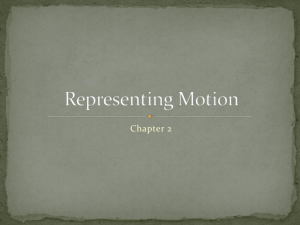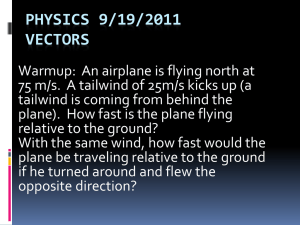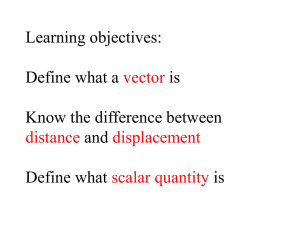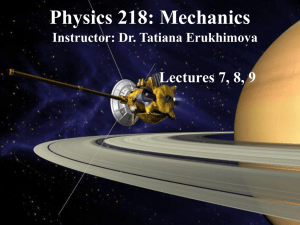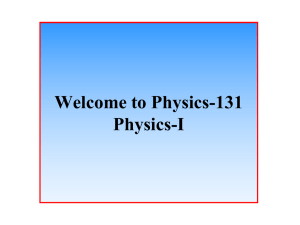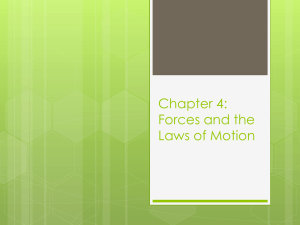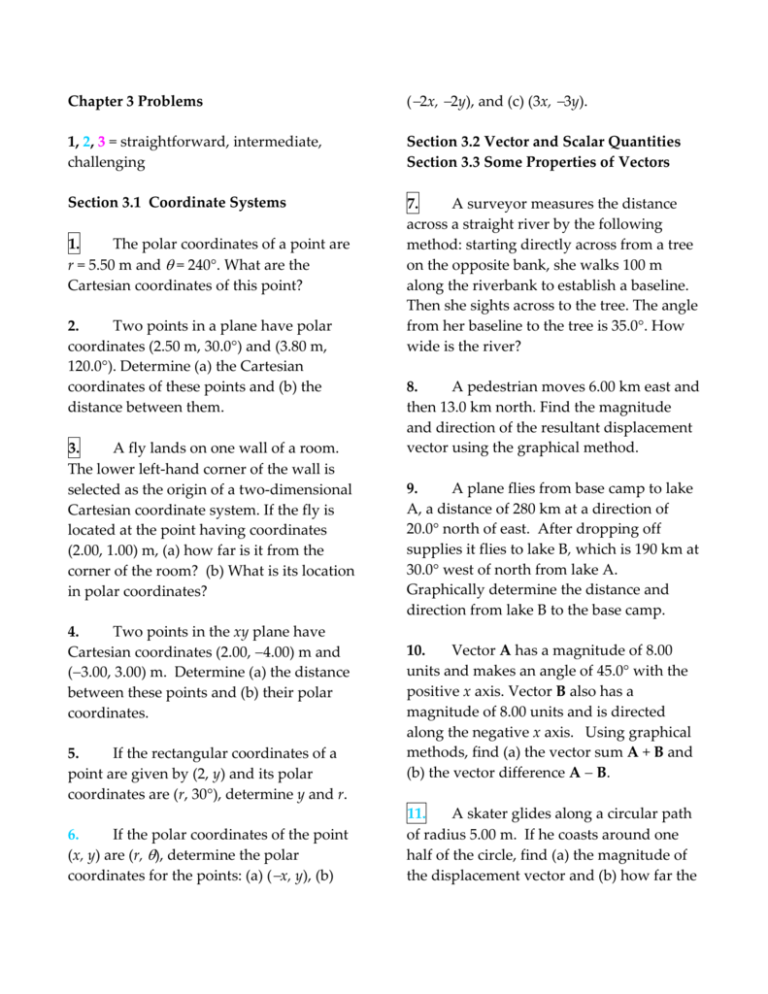
Chapter 3 Problems
(2x, 2y), and (c) (3x, 3y).
1, 2, 3 = straightforward, intermediate,
challenging
Section 3.2 Vector and Scalar Quantities
Section 3.3 Some Properties of Vectors
Section 3.1 Coordinate Systems
7.
A surveyor measures the distance
across a straight river by the following
method: starting directly across from a tree
on the opposite bank, she walks 100 m
along the riverbank to establish a baseline.
Then she sights across to the tree. The angle
from her baseline to the tree is 35.0. How
wide is the river?
1.
The polar coordinates of a point are
r = 5.50 m and = 240°. What are the
Cartesian coordinates of this point?
2.
Two points in a plane have polar
coordinates (2.50 m, 30.0°) and (3.80 m,
120.0°). Determine (a) the Cartesian
coordinates of these points and (b) the
distance between them.
3.
A fly lands on one wall of a room.
The lower left-hand corner of the wall is
selected as the origin of a two-dimensional
Cartesian coordinate system. If the fly is
located at the point having coordinates
(2.00, 1.00) m, (a) how far is it from the
corner of the room? (b) What is its location
in polar coordinates?
4.
Two points in the xy plane have
Cartesian coordinates (2.00, 4.00) m and
(3.00, 3.00) m. Determine (a) the distance
between these points and (b) their polar
coordinates.
5.
If the rectangular coordinates of a
point are given by (2, y) and its polar
coordinates are (r, 30), determine y and r.
6.
If the polar coordinates of the point
(x, y) are (r, ), determine the polar
coordinates for the points: (a) (x, y), (b)
8.
A pedestrian moves 6.00 km east and
then 13.0 km north. Find the magnitude
and direction of the resultant displacement
vector using the graphical method.
9.
A plane flies from base camp to lake
A, a distance of 280 km at a direction of
20.0 north of east. After dropping off
supplies it flies to lake B, which is 190 km at
30.0 west of north from lake A.
Graphically determine the distance and
direction from lake B to the base camp.
10.
Vector A has a magnitude of 8.00
units and makes an angle of 45.0° with the
positive x axis. Vector B also has a
magnitude of 8.00 units and is directed
along the negative x axis. Using graphical
methods, find (a) the vector sum A + B and
(b) the vector difference A B.
11.
A skater glides along a circular path
of radius 5.00 m. If he coasts around one
half of the circle, find (a) the magnitude of
the displacement vector and (b) how far the
person skated. (c) What is the magnitude
of the displacement if he skates all the way
around the circle?
12.
A force F1 of magnitude 6.00 units
acts at the origin in a direction 30.0 above
the positive x axis. A second force F2 of
magnitude 5.00 units acts at the origin in
the direction of the positive y axis. Find
graphically the magnitude and direction of
the resultant force F1 + F2.
13.
Arbitrarily define the “instantaneous
vector height” of a person as the
displacement vector from the point halfway
between his or her feet to the top of his
head. Make an order-of-magnitude
estimate of the total vector height of all the
people in a city of population 100 000 (a) at
10 o’clock on a Tuesday morning, and (b) at
5 o’clock on a Saturday morning. Explain
your reasoning.
14.
A dog searching for a bone walks
3.50 m south, then 8.20 m at an angle 30.0
north of east, and finally 15.0 m west. Find
the dog's resultant displacement vector
using graphical techniques.
15.
Each of the displacement vectors A
and B shown in Fig. P3.15 has a magnitude
of 3.00 m. Find graphically (a) A + B, (b)
A B, (c) B A, (d) A 2B. Report all
angles counterclockwise from the positive x
axis.
Fig P3.15 Problems 15 and 37
16.
Three displacements are A = 200 m,
due south; B = 250 m, due west; C = 150 m,
30.0° east of north. Construct a separate
diagram for each of the following possible
ways of adding these vectors: R1 = A + B +
C; R2 = B + C + A; R3 = C + B + A.
17.
A roller coaster car moves 200 ft
horizontally, and then rises 135 ft at an
angle of 30.0° above the horizontal. It then
travels 135 ft at an angle of 40.0°
downward. What is its displacement from
its starting point? Use graphical techniques.
Section 3.4 Components of a Vector and
Unit Vectors
18.
Find the horizontal and vertical
components of the 100-m displacement of a
superhero who flies from the top of a tall
building following the path shown in Fig.
P3.18.
What is the total distance she travels?
Fig P3.18
19.
A vector has an x component of
25.0 units and a y component of 40.0 units.
Find the magnitude and direction of this
vector.
20.
A person walks 25.0 north of east
for 3.10 km. How far would she have to
walk due north and due east to arrive at the
same location?
21.
Obtain expressions in component
form for the position vectors having polar
coordinates (a) 12.8 m, 150; (b) 3.30 cm,
60.0; (c) 22.0 in., 215.
22.
A displacement vector lying in the xy
plane has a magnitude of 50.0 m and is
directed at an angle of 120 to the positive x
axis. What are the rectangular components
of this vector?
23.
A girl delivering newspapers covers
her route by traveling 3.00 blocks west, 4.00
blocks north, and then 6.00 blocks east. (a)
What is her resultant displacement? (b)
24.
In 1992, Akira Matsushima, from
Japan, rode a unicycle across the United
States, covering about 4 800 km in six
weeks. Suppose that, during that trip, he
had to find his way through a city with
plenty of one-way streets. In the city center,
Matsushima had to travel in sequence
280 m north, 220 m east, 360 m north, 300 m
west, 120 m south, 60.0 m east, 40.0 m
south, 90.0 m west (road construction) and
then 70.0 m north. At that point, he stopped
to rest. Meanwhile, a curious crow decided
to fly the distance from his starting point to
the rest location directly (“as the crow
flies”). It took the crow 40.0 s to cover that
distance. Assuming the velocity of the crow
was constant, find its magnitude and
direction.
25.
While exploring a cave, a spelunker
starts at the entrance and moves the
following distances. She goes 75.0 m north,
250 m east, 125 m at an angle 30.0 north of
east, and 150 m south. Find the resultant
displacement from the cave entrance.
26.
A map suggests that Atlanta is 730
miles in a direction of 5.00 north of east
from Dallas. The same map shows that
Chicago is 560 miles in a direction of 21.0
west of north from Atlanta. Modeling the
Earth as flat, use this information to find
the displacement from Dallas to Chicago.
27.
Given the vectors
A 2.00 ˆi 6.00 ˆj and
B 3.00 ˆi 2.00 ˆj , (a) draw the vector
sum C = A + B and the vector difference
D = A B. (b) Calculate C and D, first in
terms of unit vectors and then in terms of
polar coordinates, with angles measured
with respect to the +x axis.
28.
Find the magnitude and direction of
the resultant of three displacements having
rectangular components (3.00, 2.00) m,
(5.00, 3.00) m, and (6.00, 1.00) m.
29.
A man pushing a mop across a floor
causes it to undergo two displacements.
The first has a magnitude of 150 cm and
makes an angle of 120° with the positive x
axis. The resultant displacement has a
magnitude of 140 cm and is directed at an
angle of 35.0° to the positive x axis. Find the
magnitude and direction of the second
displacement.
30.
Vector A has x and y components of
8.70 cm and 15.0 cm, respectively; vector B
has x and y components of 13.2 cm and
6.60 cm, respectively. If A B + 3C = 0,
what are the components of C?
31.
33.
A particle undergoes the following
consecutive displacements: 3.50 m south,
8.20 m northeast, and 15.0 m west. What is
the resultant displacement?
34.
In a game of American football, a
quarterback takes the ball from the line of
scrimmage, runs backward for 10.0 yards,
and then sideways parallel to the line of
scrimmage for 15.0 yards. At this point, he
throws a forward pass 50.0 yards straight
downfield perpendicular to the line of
scrimmage. What is the magnitude of the
football's resultant displacement?
35.
The helicopter view in Fig. P3.35
shows two people pulling on a stubborn
mule. Find (a) the single force that is
equivalent to the two forces shown, and (b)
the force that a third person would have to
exert on the mule to make the resultant
force equal to zero. The forces are measured
in units of newtons (abbreviated N).
Consider the two vectors
A 3ˆi 2 ˆj and B ˆi 4ˆj . Calculate
(a) A + B, (b) A B, (c) |A + B|, (d) |A B|,
and (e) the directions of A + B and A B .
32.
Consider the displacement vectors
A 3ˆi 3ˆj m, B ˆi 4ˆj m , and
C 2iˆ 5ˆj m . Use the component
method to determine (a) the magnitude and
direction of the vector D = A + B + C, (b) the
magnitude and direction of E = A B + C.
Fig P3.35
36.
A novice golfer on the green takes
three strokes to sink the ball. The successive
displacements are 4.00 m to the north,
2.00 m northeast, and 1.00 m at 30.0 west
of south. Starting at the same initial point,
an expert golfer could make the hole in
what single displacement?
37.
Use the component method to add
the vectors A and B shown in Figure P3.15.
Express the resultant A + B in unit-vector
notation.
38.
In an assembly operation illustrated
in Figure P3.38, a robot moves an object
first straight upward and then also to the
east, around an arc forming one quarter of a
circle of radius 4.80 cm that lies in an eastwest vertical plane. The robot then moves
the object upward and to the north, through
a quarter of a circle of radius 3.70 cm that
lies in a north-south vertical plane. Find
(a) the magnitude of the total displacement
of the object, and (b) the angle the total
displacement makes with the vertical.
Figure P3.38
39.
Vector B has x, y, and z components
of 4.00, 6.00, and 3.00 units, respectively.
Calculate the magnitude of B and the
angles that B makes with the coordinate
axes.
40. You are standing on the ground at the
origin of a coordinate system. An airplane
flies over you with constant velocity
parallel to the x axis and at a constant
height of 7.60 103 m. At time t = 0 the
airplane is directly above you, so that the
vector from you to it is
P0 7.60 10 3 m ˆj . At t = 30.0 s the
position vector leading from you to the
airplane is
P30 8.04 10 3 m ˆi 7.60 10 3 m ˆj .
Determine the magnitude and orientation
of the airplane’s position vector at t = 45.0 s.
41.
The vector A has x, y, and z
components of 8.00, 12.0, and 4.00 units,
respectively. (a) Write a vector expression
for A in unit-vector notation. (b) Obtain a
unit-vector expression for a vector B one–
fourth the length of A pointing in the same
direction as A. (c) Obtain a unit-vector
expression for a vector C three times the
length of A pointing in the direction
opposite the direction of A.
42.
Instructions for finding a buried
treasure include the following: Go 75.0
paces at 240, turn to 135 and walk 125
paces, then travel 100 paces at 160. The
angles are measured counterclockwise from
an axis pointing to the east, the +x direction.
Determine the resultant displacement from
the starting point.
43.
Given the displacement vectors
A 3ˆi 4ˆj 4kˆ m and
B 2 ˆi 3 ˆj 7 kˆ m , find the
magnitudes of the vectors (a) C = A + B and
(b) D = 2A B, also expressing each in
terms of its rectangular components.
44.
A radar station locates a sinking
ship at range 17.3 km and bearing 136
clockwise from north. From the same
station a rescue plane is at horizontal range
19.6 km, 153 clockwise from north, with
elevation 2.20 km. (a) Write the position
vector for the ship relative to the plane,
letting ˆi represent east, ˆj north, and kˆ up.
(b) How far apart are the plane and ship?
45.
As it passes over Grand Bahama
Island, the eye of a hurricane is moving in a
direction 60.0 north of west with a speed of
41.0 km/h. Three hours later, the course of
the hurricane suddenly shifts due north,
and its speed slows to 25.0 km/h. How far
from Grand Bahama is the eye 4.50 h after it
passes over the island?
46.
(a) Vector E has magnitude 17.0 cm
and is directed 27.0 counterclockwise from
the +x axis. Express it in unit-vector
notation. (b) Vector F has magnitude
17.0 cm and is directed 27.0
counterclockwise from the +y axis. Express
it in unit-vector notation. (c) Vector G has
magnitude 17.0 cm and is directed 27.0
clockwise from the y axis. Express it in
unit-vector notation.
47.
Vector A has a negative x component
3.00 units in length and a positive y
component 2.00 units in length. (a)
Determine an expression for A in unitvector notation. (b) Determine the
magnitude and direction of A. (c) What
vector B when added to A gives a resultant
vector with no x component and a negative
y component 4.00 units in length?
48.
An airplane starting from airport A
flies 300 km east, then 350 km at 30.0° west
of north, and then 150 km north to arrive
finally at airport B. (a) The next day,
another plane flies directly from A to B in a
straight line. In what direction should the
pilot travel in this direct flight? (b) How far
will the pilot travel in this direct flight?
Assume there is no wind during these
flights.
49.
Three displacement vectors of a
croquet ball are shown in Figure P3.49,
where |A| = 20.0 units, |B| = 40.0 units,
and |C| = 30.0 units. Find (a) the resultant
in unit-vector notation and (b) the
magnitude and direction of the resultant
displacement.
between R and the x, y, and z axes.
Figure P3.49
50.
If A 6.00ˆi 8.00ˆj units,
54.
The biggest stuffed animal in the
world is a snake 420 m long, constructed by
Norwegian children. Suppose the snake is
laid out in a park as shown in Figure P3.54,
forming two straight sides of a 105 angle,
with one side 240 m long. Olaf and Inge
run a race they invent. Inge runs directly
from the tail of the snake to its head and
Olaf starts from the same place at the same
time but runs along the snake. If both
children run steadily at 12.0 km/h, Inge
reaches the head of the snake how much
earlier than Olaf?
B 8.00ˆi 3.00 ˆj units, and
C 26.0ˆi 19.0 ˆj units, determine a
and b such that aA + bB + C = 0.
Additional Problems
51.
Two vectors A and B have precisely
equal magnitudes. In order for the
magnitude of A + B to be one hundred
times larger than the magnitude of A B,
what must be the angle between them?
52.
Two vectors A and B have precisely
equal magnitudes. In order for the
magnitude of A + B to be larger than the
magnitude of A B by the factor n, what
must be the angle between them?
53.
A vector is given by
R 2iˆ ˆj 3 kˆ . Find (a) the
magnitudes of the x, y, and z components,
(b) the magnitude of R, and (c) the angles
Figure P3.54
55.
An air-traffic controller observes two
aircraft on his radar screen. The first is at
altitude 800 m, horizontal distance 19.2 km,
and 25.0° south of west. The second aircraft
is at altitude 1 100 m, horizontal distance
17.6 km, and 20.0° south of west. What is
the distance between the two aircraft?
(Place the x axis west, the y axis south, and
the z axis vertical.)
56.
A ferry boat transports tourists
among three islands. It sails from the first
island to the second island, 4.76 km away,
in a direction 37.0 north of east. It then
sails from the second island to the third
island in a direction 69.0 west of north.
Finally it returns to the first island, sailing
in a direction 28.0 east of south. Calculate
the distance between (a) the second and
third islands (b) the first and third islands.
right at 55.0 below the horizontal. Follow
these steps: Make a drawing of this
situation and select the best axes for x and y
so you have the least number of
components. Then add the vectors by the
component method.
59.
A person going for a walk follows
the path shown in Fig. P3.59. The total trip
consists of four straight-line paths. At the
end of the walk, what is the person's
resultant displacement measured from the
starting point?
57.
The rectangle shown in Figure P3.57
has sides parallel to the x and y axes. The
position vectors of two corners are
A = 10.0 m at 50.0 and B = 12.0 m at 30.0.
(a) Find the perimeter of the rectangle. (b)
Find the magnitude and direction of the
vector from the origin to the upper right
corner of the rectangle.
Figure P3.59
Figure P3.57
58.
Find the sum of these four vector
forces: 12.0 N to the right at 35.0 above the
horizontal, 31.0 N to the left at 55.0 above
the horizontal, 8.40 N to the left at 35.0
below the horizontal, and 24.0 N to the
60.
The instantaneous position of an
object is specified by its position vector r,
leading from a fixed origin to the location
of the point object. Suppose that for a
certain object the position vector is a
function of time, given by
r 4ˆi 3ˆj 2tkˆ , where r is in meters
and t is in seconds. Evaluate dr/dt. What
does it represent about the object?
61.
A jet airliner, moving initially at
300 mi/h to the east, suddenly enters a
region where the wind is blowing at 100
mi/h toward the direction 30.0° north of
east. What are the new speed and direction
of the aircraft relative to the ground?
62.
Long John Silver, a pirate, has buried
his treasure on an island with five trees,
located at the following points:
(30.0 m, 20.0 m), (60.0 m, 80.0 m), (10.0 m,
10.0 m), (40.0 m, 30.0 m), and (70.0 m,
60.0 m), all measured relative to some
origin, as in Figure P3.62. His ship’s log
instructs you to start at tree A and move
toward tree B, but to cover only one-half
the distance between A and B. Then move
toward tree C, covering one-third the
distance between your current location and
C. Next move toward D, covering onefourth the distance between where you are
and D. Finally move towards E, covering
one-fifth the distance between you and E,
stop, and dig. (a) Assume that you have
correctly determined the order in which the
pirate labeled the trees as A, B, C, D, and E,
as shown in the figure. What are the
coordinates of the point where his treasure
is buried? (b) What if you do not really
know the way the pirate labeled the trees?
Rearrange the order of the trees [for
instance, B(30 m, 20 m), A(60 m, 80 m),
E(10 m, 10 m), C(40 m, 30 m), and
D(70 m, 60 m)] and repeat the calculation
to show that the answer does not depend
on the order in which the trees are labeled.
Figure P3.62
63.
Consider a game in which N
children position themselves at equal
distances around the circumference of a
circle. At the center of the circle is a rubber
tire. Each child holds a rope attached to the
tire and, at a signal, pulls on his rope. All
children exert forces of the same magnitude
F. In the case N = 2, it is easy to see that the
net force on the tire will be zero, because
the two oppositely directed force vectors
add to zero. Similarly, if N = 4, 6, or any
even integer, the resultant force on the tire
must be zero, because the forces exerted by
each pair of oppositely positioned children
will cancel. When an odd number of
children are around the circle, it is not so
obvious whether the total force on the
central tire will be zero. (a) Calculate the
net force on the tire in the case N = 3, by
adding the components of the three force
vectors. Choose the x axis to lie along one
of the ropes. (b) What If? Determine the
net force for the general case where N is
any integer, odd or even, greater than one.
Proceed as follows: Assume that the total
force is not zero. Then it must point in
some particular direction. Let every child
move one position clockwise. Give a
reason that the total force must then have a
direction turned clockwise by 360/N.
Argue that the total force must nevertheless
be the same as before. Explain that the
contradiction proves that the magnitude of
the force is zero. This problem illustrates a
widely useful technique of proving a result
“by symmetry“ by using a bit of the
mathematics of group theory. The particular
situation is actually encountered in physics
and chemistry when an array of electric
charges (ions) exerts electric forces on an
atom at a central position in a molecule or
in a crystal.
64.
A rectangular parallelepiped has
dimensions a, b, and c, as in Figure P3.64.
(a) Obtain a vector expression for the face
diagonal vector R1. What is the magnitude
of this vector? (b) Obtain a vector
expression for the body diagonal vector R2.
65. Vectors A and B have equal magnitudes
of 5.00. If the sum of A and B is the vector
6.00ˆj , determine the angle between A and
B.
66. In Figure P3.66 a spider is resting after
starting to spin its web. The gravitational
force on the spider is 0.150 newton down.
The spider is supported by different tension
forces in the two strands above it, so that
the resultant vector force on the spider is
zero. The two strands are perpendicular to
each other, so we have chosen the x and y
directions to be along them. The tension Tx
is 0.127 newton. Find (a) the tension Ty, (b)
the angle the x axis makes with the
horizontal, and (c) the angle the y axis
makes with the horizontal.
Note that R1, ck̂ , and R2 make a right
triangle and prove that the magnitude of R2
is
a2 b2 c 2 .
Figure P3.64
Figure P3.66
67.
A point P is described by the
coordinates (x, y) with respect to the normal
Cartesian coordinate system shown in Fig.
P3.67. Show that (x', y'), the coordinates of
this point in the rotated coordinate system,
are related to (x, y) and the rotation angle
by the expressions
x' = x cos + y sin
y' = x sin + y cos
Figure P3.67
© Copyright 2004 Thomson. All rights reserved.

